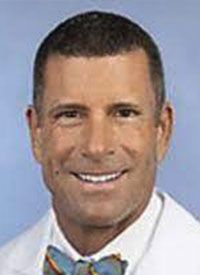Article
VTC Plus Standard Chemotherapy Fails to Improve EFS and OS in Ewing Sarcoma
Author(s):
R. Lor Randall, MD, FACS, elaborates on the results of a study and provided insight into future research directions in Ewing sarcoma
R. Lor Randall, MD, FACS

The addition of vincristine, topotecan, and cyclophosphamide (VTC) to interval compressed chemotherapy did not demonstrate an improvement in survival outcomes in untreated patients with nonmetastatic Ewing sarcoma, but did show the best estimates of event-free survival (EFS) and overall survival (OS) to date in this population, explained R. Lor Randall, MD, FACS.
In the study, patients were randomized to receive 17 cycles of standard 5-drug interval compressed chemotherapy (regimen A; n = 309) or 5 cycles of VTC within the 17 cycles of treatment (regimen B; n = 320).
EFS and OS served as co-primary end points.
The results showed that the overall 5-year EFS and OS rates were 78% and 87%, respectively. However, no difference in the 5-year EFS rates were reported between regimen A and B, at 78% vs 79%, respectively (P = .192). Similarly, no difference in the 5-year OS rates were reported, at 86% vs 88%, respectively (P = .159).
Additional findings showed that age and primary site did not influence the likelihood of an EFS event. However, patients at least 18 years of age had an increased risk of death at 5 years (HR, 1.84; 95% CI, 1.15-2.96; P = .009). The 5-year EFS rates for patients with pelvic, nonpelvic bone, and extraosseous primary tumors were 75%, 78%, and 85%, respectively. Moreover, tumor volume of at least 200 mL was significantly associated with lower EFS.
In an interview with OncLive®, Randall, The David Linn Endowed Chair for Orthopaedic Surgery and professor and chair of the Department of Orthopaedic Surgery, University of California Davis Health, elaborated on the results of the study and provided insight into future research directions in Ewing sarcoma.
OncLive®: Why evaluate the addition of VTC to standard therapy in Ewing sarcoma?
Randall: We recently published this paper in the Journal of Clinical Oncology, and I want to give a big shout out to Patrick Leavey, MD, of UT Southwestern Medical Center who is the principal investigator in the Children’s Oncology Group Bone Group for this phase 3 trial, where we added VTC to the treatment of patients with nonmetastatic Ewing sarcoma.
There has been some work looking at compressive interval therapy for Ewing sarcoma, but we haven’t really been able to move the needle in terms of EFS and OS, so we did a study, under the leadership of Dr Leavey, to look at adding these agents to the compressed backbone therapy for Ewing sarcoma. Unfortunately, [the addition of these agents] didn’t prove to be any different; the outcomes were pretty much unchanged whether you got the VTC interval between the compressed backbone, but we did see 5-year EFS and OS rates of 78% and 87%, respectively, for Ewing sarcoma, which is really an uptick in survivorship overall. It’s just that this regimen didn’t prove to be advantageous in a randomized trial.
Did the addition of VTC to standard therapy affect the tolerability of the regimen?
The overall toxicity was not impacted [with the addition of VTC]; the usual adverse effects were seen. Patients seemed to tolerate the regimen well, it just didn’t [improve outcomes], which brings home the point that we have exhausted all the conventional drugs in treating these kids and that we need to start building in the multikinase TKIs.
How have the results of this study focused future research efforts?
The lessons learned are that more of the conventional cytotoxic agents aren’t necessarily going to improve [outcomes] and that we’re not going to change EFS and OS [by adding VTC to standard treatment]. [Now, there is] more argument to be made to look at some of the newer, exciting agents. [To that end], we are starting to construct a study using a multi-targeted TKI to build out future studies because we really exhausted all conventional cytotoxic therapy.
One study that’s in development right now is looking at regorafenib [Stivarga], which we’re going to use with conventional backbone therapy. It’s exciting that this will be the first time this agent is [evaluated in] this cohort of patients.
How do the standard treatment regimens for patients with Ewing sarcoma compare with those for patients with osteosarcoma?
For pediatric bone sarcomas, there are 2 major classes: osteosarcoma and Ewing sarcoma. Patients with osteosarcoma typically receive ifosfamide/doxorubicin backbone therapy with high-dose methotrexate. Patients with Ewing sarcoma typically receive vincristine, doxorubicin, cyclophosphamide, ifosfamide, and etoposide and sometimes topotecan. We have different agents for the 2 different types of tumors, but the regimens have very similar cytotoxic profiles.
What may be contributing to the improved outcomes that were seen in the study if not for the experimental treatment regimen?
The exciting thing is that the 5-year EFS rate was 78%, and the 5-year OS rate was 87%, which is pretty good. [These rates just aren’t] dependent upon adding in the additional agents. Historically, we have been hovering around 70%. For whatever reason, these patients seem to be doing better than they have historically.
That may speak to some sort of effect of the agility with which we’re diagnosing tumors sooner, getting patients onto trials sooner, and the fact that the teams that are working for these patients are truly transdisciplinary and are there at the start and working with the patients through the whole process, whereas before with some of the studies, our multidisciplinary treatment approach wasn’t as refined.
Reference
- Leavey PJ, Laack NN, Krailo MD, et al. Phase III trial adding vincristine-topotecan-cyclophosphamide to the initial treatment of patients with nonmetastatic Ewing sarcoma: a Children’s Oncology Group Report. J Clin Oncol. Published online October 15, 2021. Accessed December 10, 2021. doi:10.1200/JCO.21.00358









